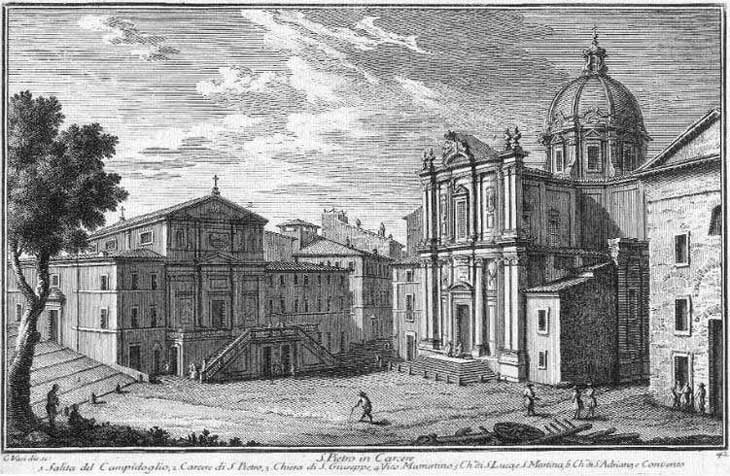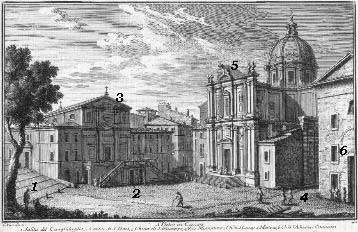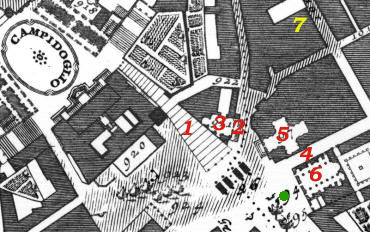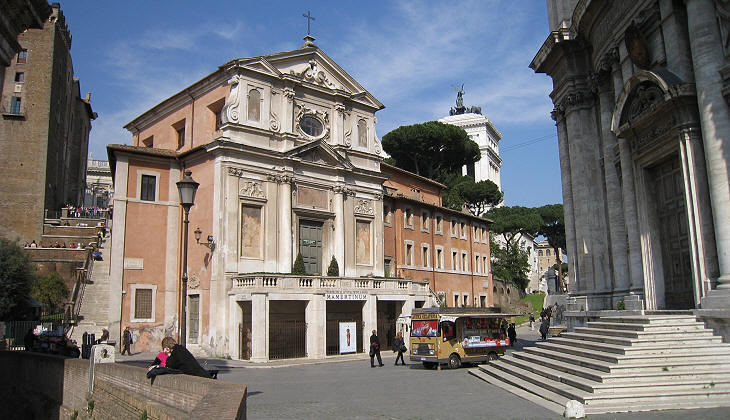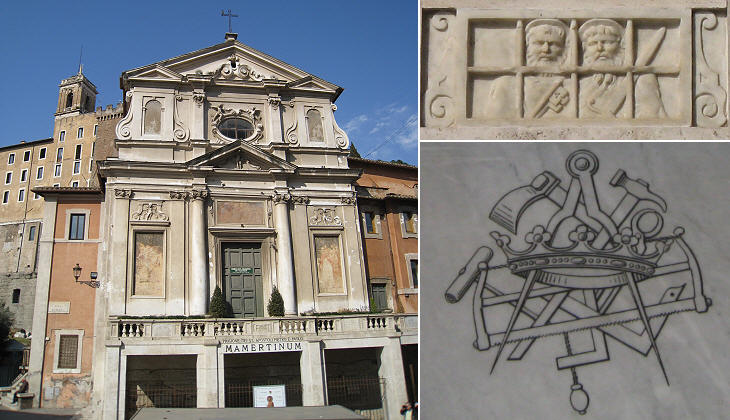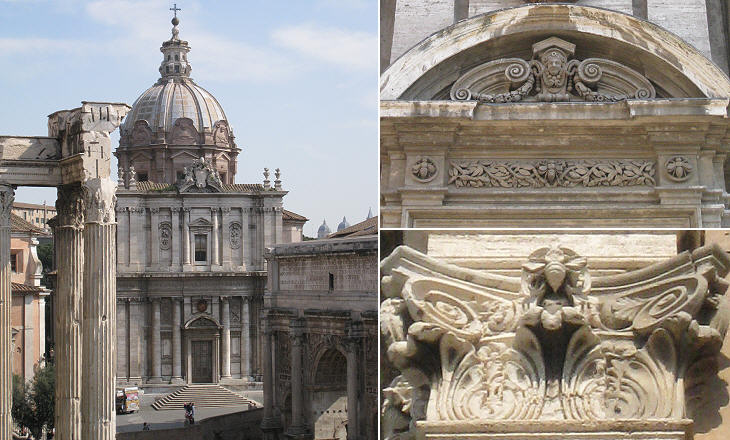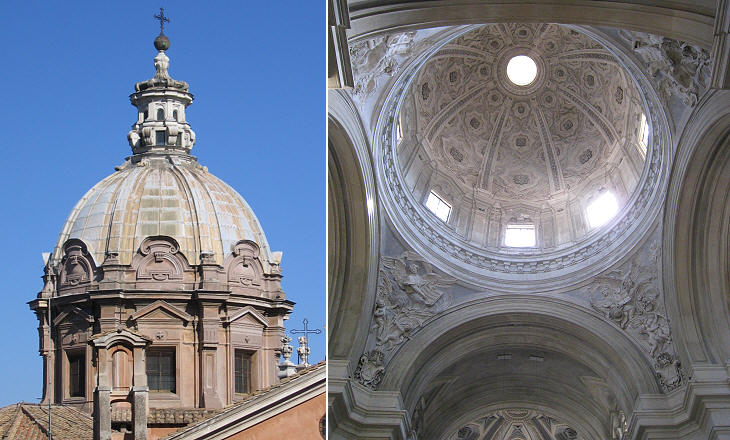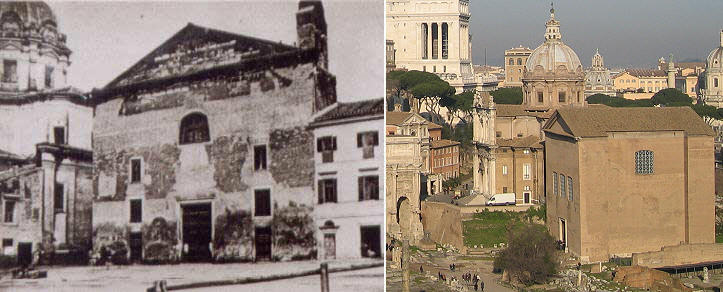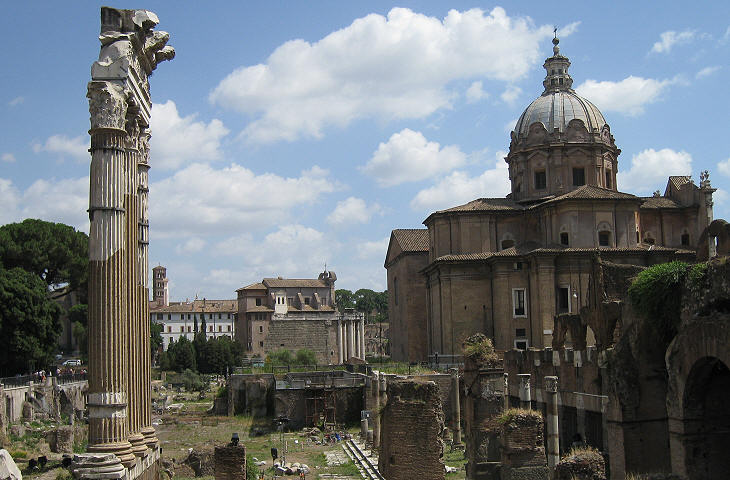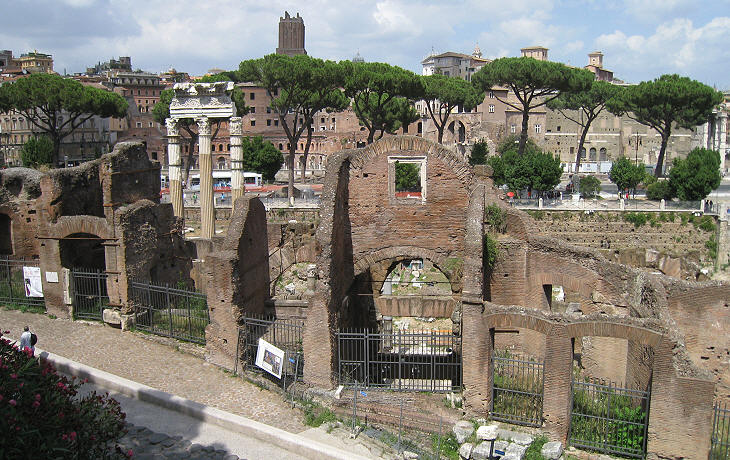  What's New! Detailed Sitemap All images © by Roberto Piperno, owner of the domain. Write to romapip@quipo.it. Text edited by Rosamie Moore. Page revised in August 2009. | S. Pietro in Carcere (Book 3) (Day 1) (Map B3) (Rione Campitelli) and (Rione Monti)
In this page:
S. Pietro in Carcere or Carcere Mamertino is the name given during the Middle Ages to a prison which the ancient Romans called Tullianum. According to tradition St. Peter was imprisoned here during the reign of Emperor Nero. However Vasi's etching does not have any echoes of this past. We can see instead how ancient buildings were incorporated into three adjoining churches (S. Giuseppe dei Falegnami was built above the prison, SS. Luca e Martina most likely above Secretarium Senatus, a criminal court, and S. Adriano inside Curia Julia). The view is taken from the green dot in the small 1748 map here below. In the description below the plate Vasi made reference to: 1) the street leading to Campidoglio; 2) Carcere di S. Pietro (Mamertino); 3) Chiesa di S. Giuseppe; 4) Vico Mamertino (a small street); 5) SS. Luca e Martina; 6) S. Adriano. The small map shows also: 7) Foro di Cesare. The dotted line in the small map delineates the border between Rione Campitelli (left) and Rione Monti (right).
The large excavations in the Forum, the construction of the Monument to King Victor Emmanuel II and later on the opening of Via dei Fori Imperiali, have isolated two churches from the rest of the city, whereas S. Adriano is part of the archaeological area. The steps leading to Campidoglio were known at the time of the Roman Empire as Scalae Gemoniae and were used to display the bodies of prisoners executed because of a particularly dishonourable conduct. S. Giuseppe dei Falegnami
In the IVth century the prison was turned into an oratory dedicated to St. Peter (and St. Paul); in the XVIth century it was assigned to the joiners' (It. falegnami) guild; the underground room which housed the oratory was felt inappropriate for the meetings of an important guild. The construction of a church above the prison took a long time and it was not consecrated until 1663. The façade was designed by Giovan Battista Montani in 1602, but its stucco decoration belongs to a later period. It was dedicated to S. Giuseppe, the patron saint of the guild (click here to see other churches belonging to a guild). SS. Luca e Martina
In the VIIth century a church dedicated to S. Martina, a IIIrd century martyr, was built above the remains of the ancient Secretarium Senatus. This was most likely a criminal court of the Late Empire. In 1588 the church was assigned to the guild of the painters, which had recently changed its name from Università dei Pittori to Accademia di S. Luca. The devotion to St. Luke was due to the account that he had painted the first icons portraying the Virgin Mary. The appointment in 1626 of Cardinal Francesco Barberini, nephew of Pope Urban VIII, as titular of the church and that in 1634 of Pietro da Cortona as leader of the guild paved the way for the construction of a new church dedicated to St. Luke. Initially Pietro da Cortona had just in mind to build his own funerary chapel, but the discovery of the body of S. Martina led Cardinal Barberini to finance the construction of a new grand church dedicated to both saints.
Although Pietro da Cortona is mainly remembered for his paintings, the church he designed and where he was buried, is regarded as a masterpiece of baroque architecture. The coat of arms of the façade was included by Filippo Juvarra in his selection of coats of arms. Curia Julia
Curia Julia, the hall where the Senators met, was built by Julius Caesar on a previous one Curia Hostilia, named after Tullius Hostilius, the third king of Rome. The hall was rebuilt by Emperor Diocletian after a fire. It was turned into a church in 625; it was dedicated to St. Hadrian of Nicomedia, a IVth century martyr; later on its floor was raised and a three nave church was built inside the ancient walls. In 1930-36 all the additions were removed and the entrance, which in the plate is shown at the level of the other churches, was brought back to its original location. In the XVIIth century its bronze doors were relocated to S. Giovanni in Laterano and they are still there. You may wish to see the building as it appeared in a 1588 Guide to Rome. Foro di Cesare
In the 1930s the excavations of an area behind the church of SS. Luca e Martina led to the discovery of the Forum built by Julius Caesar: it included a temple to Venus, of which three columns have been re-erected. Other buildings which have come to light include five tabernae and the columns of a portico.
Excerpts from Giuseppe Vasi 1761 Itinerary related to this page:
Next plate in Book 3: S. Paolo alle Tre Fontane Next step in Day 1 itinerary: Parte di Campo Vaccino verso l'Arco di Tito You have completed your tour of Rione Monti! Start your tour of Rione Campitelli: next step: SS. Venanzio e Ansovino |
